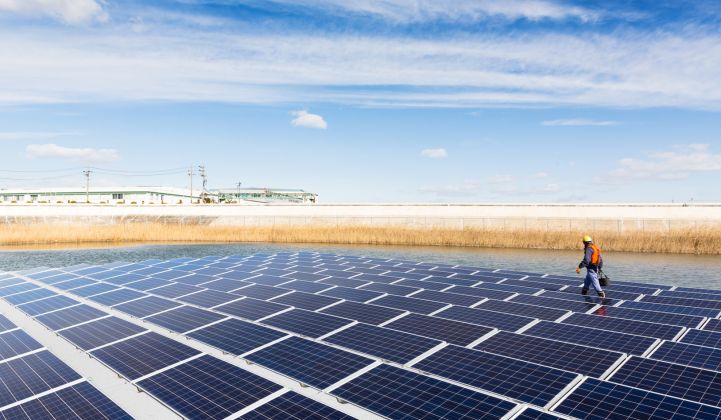Humans have been floating on water for thousands of years, so perhaps it was inevitable that they would build solar plants on it, too.
Floating photovoltaics have already delivered 1.1 gigawatts of installations worldwide, according to the World Bank. That’s a small slice of the broader solar industry, which now installs close to 100 gigawatts a year. That said, floating solar excels in markets where land is scarce or otherwise unavailable, and that tracks well with major growth markets for the solar industry, analysts noted at GTM’s Solar Summit in Scottsdale last week.
Putting solar on the water costs more than building it on land — although there is little data to show exactly how much — but it brings several operational benefits. Most importantly, it allows developers to generate power without taking land offline for other uses, which is already becoming table stakes in certain densely populated regions.
“It’s ideal in places where you have limited land availability,” said Teresa Barnes of the National Renewable Energy Laboratory.
Better where it’s wetter
Floating developers aren’t targeting just any body of water. They’re focusing on the aquatic equivalent of a brownfield site: man-made, inland, generally calm.
Exposing a solar installation to battering ocean waves, or plopping one on a pristine natural lake, is not on the menu so far.
Floating solar makes the most sense in areas where land is expensive, or required for more valuable uses, like agriculture. Man-made pools can also offer space to generate power close to the point of use when it otherwise would not be possible.
Densely populated Japan led the floating market early on, and China and Southeast Asian nations are early adopters. Dutch companies are looking into the technology to serve the many inland water bodies in that country. Only a few projects have popped up in the land-rich U.S. — 14 by the end of 2018, according to Scientific American.
Dense regions have reason to examine floating solar, but so do landowners who want to produce power without sacrificing any useful acres of land.
“It’s another tool in the toolbox of a developer to come to these communities and have something that doesn’t take up a whole lot of their land area,” said Robert Spencer, a researcher at NREL.
Besides creating market opportunities, the siting of solar modules on water produces operational benefits.
In hot environments, the water cools down the equipment relative to a land-based system. Floating module temperatures can be 5 to 10 degrees Celsius lower than on a roof, and that differential boosts performance, Barnes said. Developers can choose pontoon styles to maximize this effect.
Most intriguing, from a grid operations perspective, is the combination of floating solar with hydroelectric dams. Since the dams already have transmission hookups and are themselves dispatchable, this arrangement could allow the solar to generate without curtailment and reach market with lower interconnection costs.
That logic could even extend to floating solar on pumped hydro facilities, which would convert the solar generation directly into stored energy onsite. This has not yet been built, and it's not clear that the economics would make sense, Barnes cautioned.
How big is the market, really?
Lack of precise data poses a major obstacle to floating solar growth, much as it does for the emerging bifacial module market.
Developers have a limited amount of evidence to convince customers that the lifetime performance justifies the upfront cost premium. Wear and tear in wet environments looks different from land-based operations and maintenance.
The scale of potential floating sites justifies continued exploration. The World Bank estimated a worldwide potential of 400 gigawatts, conservatively.
Spencer modeled the U.S. potential in an article published in the journal Environmental Science and Technology. After winnowing down the population of man-made water bodies to avoid use conflicts, the authors found that even a small fraction of suitable sites could supply 10 percent of current U.S. electricity generation.
Whether or not an economic case exists for all those sites is another matter, but the study indicates that U.S. solar needn't slow down when the nice flat open spaces get gobbled up for development.
Early floating projects will proceed where the unique benefits of floating PV outweigh the risks, said Molly Cox, an analyst working on forthcoming floating PV research at Wood Mackenzie Power & Renewables.
"Then, as more systems are built out, we will have more performance data and therefore more certainty for financiers and developers," she noted.
If so, the first gigawatt of floating solar was just skimming the surface.




